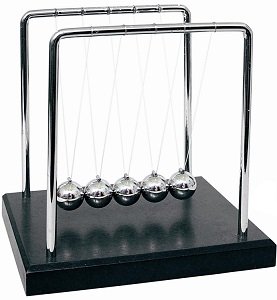Newton's Cradle

This is one of the best known science toys. It consists of five metal balls suspended in a row by way of strings connected to a support frame. When you lift up one or more of the balls from either side and release them, they fall and impact the other balls and create an interesting action and reaction effect. The video below shows examples of this.
Check out a video of Newton's cradle:
For example, let's say we lift the ball on one end up a certain height and then release it. When the ball falls and strikes the next ball beside it, it transfers its kinetic energy to it (kinetic energy is the energy of motion). That energy is transferred along the (stationary) balls which are in contact with each other. When this energy reaches the remaining ball at the free end, it rises up almost the same height as the initial ball. The height reached will not be exactly the same because of small energy losses in the system, such as friction and heat loss. These losses occur naturally and can only be minimized, but never entirely eliminated.
There are of course many more tricks one can do using a Newton's cradle, as shown in the video. All of these involve the exchange of kinetic energy between the balls, causing an interesting display of action and reaction.
In one of the Mythbusters episodes, a giant Newton's cradle was built. This is shown in the video below.
Although this was not mentioned in the episode, the reason why the giant Newton's cradle experienced so much energy loss was because the high impact force between the balls caused the metal to permanently deform. The deforming metal absorbed a lot of energy, which in turn lowered the kinetic energy of the system. This caused the ball on the free end to reach a much lower height than it would if there were no energy losses. In a small desktop Newton's cradle, the impact force between the balls is much smaller, and not nearly enough to permanently deform the metal. As a result, energy transfer becomes much more efficient between the balls.
Return to Science Toys page
Return to Real World Physics Problems home page
Free Newsletter
Subscribe to my free newsletter below. In it I explore physics ideas that seem like science fiction but could become reality in the distant future. I develop these ideas with the help of AI. I will send it out a few times a month.